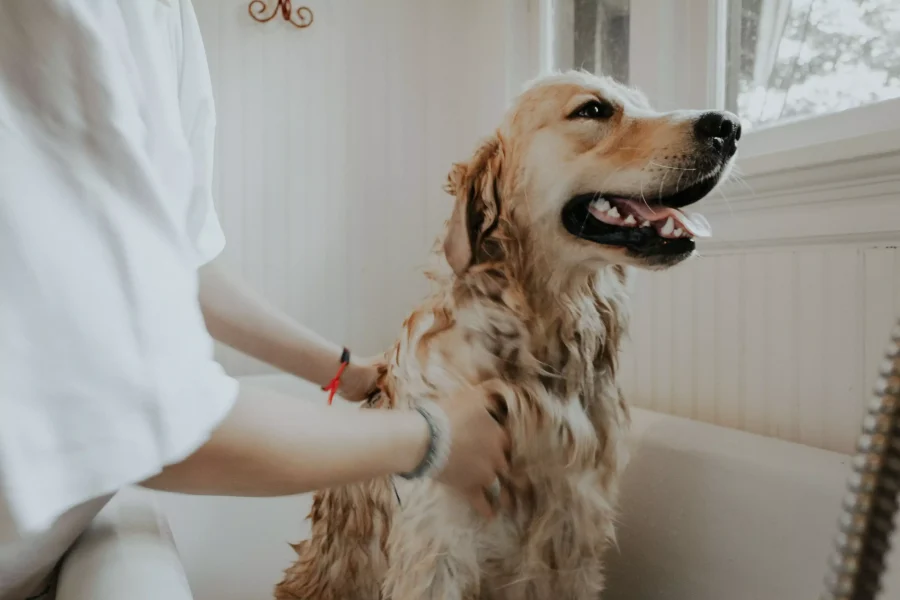Imagine coming home after a long day, eagerly anticipating the warm welcome of your pet. However, for pet owners with allergies, this scenario often transforms into a distressing ordeal. Pet dander, a common allergen produced by our furry companions, can trigger a range of allergic reactions, ranging from mild irritation to severe respiratory distress. Managing pet dander effectively requires a multifaceted approach that combines environmental modifications, responsible pet care practices and possibly medical interventions.
Pet dander consists of microscopic skin cells, saliva, and urine particles shed by animals, predominantly cats, and dogs. These minuscule allergens become airborne and can settle on various surfaces in our homes, including furniture, carpets, and clothing, lingering for extended periods. Individuals sensitive to pet dander may experience symptoms such as sneezing, coughing, nasal congestion, itchy eyes, and even asthma attacks. However, this does not mean pet ownership is off-limits for those with allergies; rather, it necessitates a proactive approach to minimize exposure and effectively manage symptoms.
Regular Grooming Practices: Key to Minimizing Pet Dander
- Importance of Brushing:
One of the fundamental aspects of managing pet dander is a regular and thorough brushing of your furry friend’s coat. Brushing serves multiple purposes beyond just keeping its fur neat and tidy. It plays a pivotal role in reducing the amount of loose hair and dander that can be shed into the environment.

Brushing helps to remove loose and dead hair from your pet’s coat before it has a chance to become airborne, contributing to the overall dander load in your home. By capturing loose hair in the brush, you can significantly minimize the dispersion of allergens. This practice is particularly crucial for individuals who are sensitive to pet dander. Additionally, brushing promotes a healthy coat by distributing natural oils, which can help reduce dry skin and subsequent dander production. Furthermore, regular grooming sessions can foster a stronger bond between you and your pet, providing a positive and enjoyable experience for both parties.

- Using a Damp Cloth for Wiping:
In addition to regular brushing, incorporating wiping with a damp cloth into your pet care routine can be highly effective in managing pet dander. Damp wiping aids in capturing and removing dander that may have settled on your pet’s fur, preventing it from becoming airborne and exacerbating allergic reactions.
When wiping your pet, ensure that the cloth is slightly moist, as excessive wetness can lead to discomfort and potential skin issues. Gently run the cloth over your pet’s body, paying close attention to areas that tend to accumulate more dander, such as their back, tail, and paws. This process helps trap dander particles, keeping them from dispersing into the environment. Remember to use pet-friendly wipes, a natural conditioning between-bath spray or a soft, lint-free cloth to prevent any potential irritation or adverse reactions.
By prioritizing regular brushing and incorporating damp wiping into your pet care practices, you can proactively manage pet dander. These simple yet essential grooming techniques contribute to reducing allergen dispersal, promoting a healthier and more comfortable environment for both pet owners and allergy sufferers alike.
Air Filtration and Purification: Enhancing Indoor Air Quality
- Choosing High-Quality Air Purifiers:
When it comes to managing pet dander, investing in a high-quality air purifier can significantly improve indoor air quality and reduce allergen exposure. Selecting the right air purifier involves considering several key factors.
- First, ensure that the air purifier is specifically designed to target pet dander and allergens.
- Look for models that mention “pet dander” or “allergen removal” in their features or specifications. These units are equipped with specialized filters and technologies to effectively capture and eliminate airborne allergens, including pet dander particles.
- Consider the size of the room or area where the air purifier will be used.
- Choose a purifier with an appropriate Clean Air Delivery Rate (CADR) that matches the room’s square footage. A higher CADR indicates that the purifier can effectively filter and circulate the air in a larger space, ensuring optimal performance.
- Opt for air purifiers with multiple filtration stages. These typically include a pre-filter to trap larger particles like pet hair, followed by a HEPA filter to capture smaller allergens such as pet dander.
- Some advanced models may also feature additional filters or technologies like activated carbon filters or UV germicidal lamps to further enhance air purification.
- HEPA Filters for Effective Dander Removal:
High-Efficiency Particulate Air (HEPA) filters are an essential component of air purifiers for efficient pet dander removal. HEPA filters are designed to capture 99.97% of particles as small as 0.3 microns in size, which includes pet dander allergens. These filters consist of a dense mat of randomly arranged fibers that create a labyrinth-like structure, effectively trapping and immobilizing pet dander particles as air passes through.
HEPA filters are highly efficient and reliable in removing dander from the air, improving indoor air quality, and reducing allergy symptoms. When selecting an air purifier, ensure it is equipped with a true HEPA filter to ensure optimal filtration efficiency. Keep in mind that HEPA filters require periodic replacement to maintain their effectiveness. Check the manufacturer’s instructions for the recommended filter replacement schedule and follow it accordingly.
Treatment Options for Pet Dander Allergies: Finding Relief and Long-Term Management
A. Medications for Symptom Relief:
- Over-the-Counter Antihistamines:
For individuals seeking immediate relief from pet dander allergy symptoms, over-the-counter antihistamines can be a valuable option. Antihistamines work by blocking the action of histamine, a substance released by the body in response to allergen exposure, which leads to allergy symptoms such as sneezing, itching, and nasal congestion.
Common antihistamines available without a prescription include cetirizine, loratadine, and fexofenadine. These medications can help alleviate allergic reactions caused by pet dander, providing temporary relief from symptoms. However, it is important to follow the recommended dosage and consult with a healthcare professional before using, especially if you have any underlying medical conditions or are taking other medications.

- Nasal Corticosteroids:
Nasal corticosteroids are a potent class of medications that reduce inflammation in the nasal passages, effectively alleviating symptoms of pet dander allergies. These medications are available in both prescription and over-the-counter forms.
Nasal corticosteroids work by suppressing the immune response to allergens, reducing nasal congestion, sneezing, itching, and inflammation. Common examples include fluticasone, budesonide, and mometasone. They are typically used as a long-term treatment for allergic rhinitis and can provide significant relief for individuals with pet dander allergies. Again, please consult your physician prior to using any medications for dander relief.
B. Immunotherapy for Long-Term Management:
- Allergy Shots and Their Effectiveness:
Immunotherapy, specifically allergy shots, is a long-term management option for individuals with pet dander allergies. Allergy shots work by gradually desensitizing the immune system to specific allergens, including pet dander. The process involves regular injections of small amounts of the allergen over a period of time, usually several years. Allergy shots help the immune system build a tolerance to pet dander allergens, reducing the severity of allergic reactions over time. This treatment approach can provide long-lasting relief and potentially reduce the need for medication use.
It is important to note that allergy shots are typically prescribed and administered by allergists or immunotherapy specialists. The effectiveness of allergy shots can vary depending on the individual and the specific allergens involved. Therefore, it is essential to consult with an allergist to determine if this treatment option is suitable for you.
- Commitment and Regular Visits to Allergists:
Immunotherapy, including allergy shots, requires a commitment to regular visits and adherence to the prescribed treatment schedule. Initially, frequent visits to the allergist are necessary for the administration of the shots and monitoring of the treatment’s effectiveness.
Over time, the frequency of visits may decrease as the treatment progresses. However, it is crucial to follow the recommended treatment plan and attend follow-up appointments to ensure the desired therapeutic outcomes. Allergists can assess your progress, adjust the treatment as needed, and provide guidance on managing pet dander allergies effectively.
Natural Shampoos for Managing Pet Dander: A Safer and Healthier Option
Benefits of Using Organic Natural Shampoos:
When it comes to managing pet dander and maintaining the health of your furry companion, opting for organic natural shampoos can offer several benefits over conventional pet shampoos. These benefits include:

- Reduced Chemical Exposure: Organic natural shampoos are formulated without harsh chemicals, synthetic fragrances, parabens, sulfates, and artificial colors. By choosing these products, you can minimize your pet’s exposure to potentially irritating or harmful substances commonly found in conventional shampoos. When formulated with 100% natural ingredients designed to keep the dog’s or cat’s skin’s oil balanced, pet owners will reduce the risk of skin allergies, dryness, excessive shedding and other adverse reactions.
- Gentle and Soothing: Natural shampoos often contain mild ingredients that are gentle on your pet’s skin. They are designed to cleanse without stripping away essential oils or causing dryness, which can lead to increased dander production. These shampoos help maintain the natural balance of your pet’s skin, keeping it moisturized and healthy.
- Environmentally Friendly: Organic natural shampoos are typically made from sustainably sourced ingredients and are biodegradable. They are less likely to contribute to environmental pollution compared to shampoos containing harsh chemicals that can harm aquatic life or contaminate water sources.
When selecting a natural shampoo for managing pet dander, look for products that prominently feature organic plant-based ingredients. However, keep in mind that each pet is unique, and it is important to consider any individual sensitivities or allergies they may have. It is advisable to conduct a patch test and closely observe your pet’s reaction to a new shampoo before full use.
Conclusion
Intriguingly, recent advancements in pet dander management have emerged, including innovative products such as anti-allergen sprays and fabrics designed to repel allergens. These cutting-edge solutions aim to create an environment where pet and allergy sufferers can coexist harmoniously, ensuring the joy and companionship of pets can be enjoyed without sacrificing comfort and well-being.
Overall, managing pet dander allergies requires a comprehensive approach that integrates environmental modifications, dander-reduction pet care practices and possibly medical interventions. By combining these strategies, people with allergies can minimize their exposure to allergens and mitigate the associated symptoms, so everyone may enjoy life with pets while maintaining optimal health and well-being.
#petdander #dander #pets #dogs #cats










